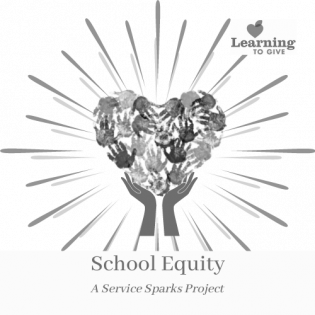Service Sparks: Advocacy for School Equity
Keywords:
Advocacy
Equity
SimpleSafeService
Social Action
Visual Arts
Ignite meaningful action that lights up the world through "Service Sparks" youth projects! This service project guides young people to identify inequalities in policies and practices and learn the processes by which young people can freely express concerns in their learning environment. They practice listening, articulating needs positively and respectfully, and advocating for change for the good of all.
SERVICE SPARKS
Ignite meaningful action that lights up the world through "Service Sparks" youth projects!
Young people often observe or experience practices that are inequitable in their learning environment. This may include racial inequities or micro-aggressions, a lack of choices in the cafeteria that reflect cultures, fewer sports opportunities for girls, no gender-neutral bathrooms, or more opportunities for students with the fewest barriers to success. In this activity, young people identify the established processes and constructive ways to move toward positive change. They become aware that their actions and decisions contribute to the quality of the world we share.
- For one example of people naming an inequity and taking action to make a better, more equitable world, read and discuss the summary of the Brown vs. Board of Education court case.
- Discuss how speaking up about inequity is an act of philanthropy. Philanthropy is giving time, talent, treasure, connections and voice to take action for the good of all. As part of a community, I have a voice and can make a difference, working with people from within to make a change with respect and sensitivity for different perspectives.
- Before starting this project, meet with the school counselor, administrator or student government sponsor to discuss how student concerns are addressed. Determine who is a good person with whom young people can safely explore concerns. Discuss how school policies are created, amended or removed. Discuss the process of resolving issues and concerns in your learning space. Is there a form? How will requests be received? What issues are already under observation? How will you protect student safety as they speak up?
- Discuss any inequities observed. One place to start is the school policy handbook that everyone is given and told to read at the beginning of the school year. Young people most affected by the policies should read the handbook with a red pen and mark any language or policies that reinforce inequities.
- Clearly state in writing the equity issues observed. For example, "Students of color are less often recommended for opportunities outside the school day, such as volunteer opportunities."
- Write a statement about why making a change in policy related to the stated issue is good for all in relation to diversity, equity, and inclusion. Reflect on how our actions and decisions contribute to the quality of the world we share.
- Collaboratively write a call to action for resolving the inequity, including steps and a final vision.
- Bring these three statements (issue, rationale, and call to action) through the established process to advocate for change.
- Document the process, keeping track of actions, using writing, drawing, and other arts. This may become part of a final display or communication about the process.
Reflection:
- What are your thoughts as you worked on the project?
- What did you learn from working with school decision-makers?
- What were the pros and cons of this project?
- What would you change?
Explore more Service Sparks activities.
Learning to Give ...
- educates youth about philanthropy, the civil society sector, and the importance of giving their time, talent and treasure for the common good (knowledge),
- equips youth by encouraging philanthropic behavior and experience (skills), and,
- empowers youth to take voluntary citizen action for the common good in their classrooms, lives and communities (behavior).
